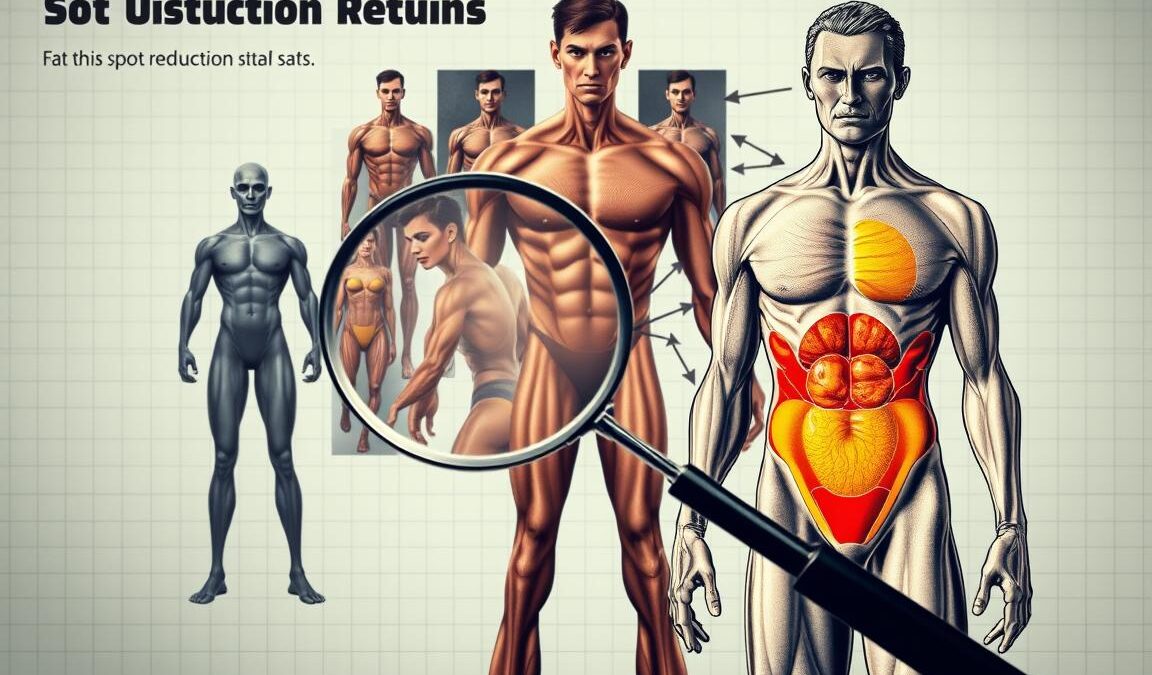
Spot Reduction Myth: Why You Can’t Lose Fat From One Area
You’ve probably trained a trouble area and felt frustrated when it didn’t change. That sting is common because fat loss works across the whole body, not like a local switch you can flip. Studies following arm-only and ab-focused programs show the body pulls energy systemically, so targeted moves build muscle but rarely burn nearby fat.
Think of this as biology, not bad coaching. The best way to get consistent results is simple: balanced strength, sensible cardio, steady nutrition, and recovery that fits your life. We’ll give clear, practical steps so you can change your composition without chasing a quick fix.
Key Takeaways
- Fat loss is systemic: training one area rarely removes local fat.
- You can build muscle locally, but biology decides where fat comes off.
- Research shows targeted training doesn’t add extra abdominal or arm fat loss.
- Focus on strength, cardio, nutrition, and recovery for lasting change.
- Measure progress by composition and performance, not just weight.
What people really mean by “spot reduction” and why it persists
When someone talks about targeting a body part, they usually picture shrinking only that area. That idea feels tidy: train the part, change the part. It’s easy to understand and even easier to sell.
Common targets include belly fat, upper arm softness, and hips or thighs. These are typical storage sites and often the slowest to change, which makes them obvious targets for quick-fix promises.
The marketing angle is simple. Short, catchy workouts and “7-day” challenges perform well on feeds because they’re visual and fast to film. People see muscle burn and assume fat is leaving that same patch of skin.
Why the idea sticks
- You feel local muscle fatigue during workouts, which feels like progress even when fat loss is systemic.
- Time pressure and busy lives make the promise of a one-part solution attractive.
- A better way: use targeted moves to build strength and shape a part, while relying on whole-body approaches to lower overall weight and improve health.
Spot reduction myth explained: the science of systemic fat loss
Your body follows rules, not wishes, when it decides what fuel to burn. During activity you tap carbohydrate first for quick energy. When demand extends—long workouts, repeated efforts, or fasting—you rely more on stored fat.
The burn you feel is muscle signaling, not proof that nearby fat is being used. Studies like Katch et al. (1983), a 2011 abdominal program, and a 2013 one-leg press trial found no extra belly or leg fat loss from training just that area.
Genetics, hormones, and current body composition shape where body fat goes and comes off. Some people lose weight from the face and arms early; others hold on to belly or hips longer.

Key physiology in plain terms
- Your body manages fuel like a budget: carbs first, then fat when demand is prolonged or you’re in an energy deficit.
- Local lipolysis can rise near active muscle because of blood flow and hormones, but that alone doesn’t guarantee local fat loss.
- Takeaway: build strength where you want shape, then use consistent training, diet, and recovery to lower overall fat stores and reveal that muscle.
Training a muscle vs. losing fat from that area: key differences
Training a muscle and removing nearby fat are two different jobs your body handles separately. Strength work builds size and capacity in the muscle beneath the skin. Fat loss is a body-wide process that follows calories, hormones, and genetics.
Classes split by upper, lower, core, or full-body exist so you can organize effort and recovery across muscle groups. Those splits help you progress in strength and make workouts manageable. They do not drive local subcutaneous fat reduction.
- Train to grow: strength training grows and strengthens a muscle; fat loss uncovers that shape.
- Working an arm or thigh makes the part stronger, not guaranteed to burn the fat over it first.
- Keep a balanced routine: heavy compound lifts, some isolation for weak spots, and enough weekly movement to support overall fat loss.
- Expect visuals to lag where you store fat; measure progress with weight lifted, reps, and form—not just the mirror.
What the research shows about spot reduction claims
Trials across decades give a consistent message: focused training builds strength where you work, but fat loss tends to show up across the whole body.
Arm and ab studies: fat loss happens across the body, not just the trained area
Classic work, including a 2007 MSSE trial with 104 people who trained one arm for 12 weeks, improved strength but did not remove more fat from the trained arm. Changes occurred systemically.
Katch et al. (1983) and a 2011 ab program found no extra belly fat loss from sit-ups or core routines when overall body fat didn’t change.
Newer findings on local fat use: spot lipolysis vs. meaningful spot reduction
Imaging studies like Kostek et al. (2007) and a 2013 one-leg press trial backed the same pattern: no clear extra leg or arm fat loss. The trunk often lost more first, especially in overweight adults and women.
That said, newer research shows local lipolysis can happen. It may lead to tiny regional effects if heavy local training is paired with cardio and a calorie deficit. Think of those as small bonuses, not a main plan.
Why methodology matters: energy deficit, training intensity, and total fat loss
Design drives outcomes. If a program doesn’t produce meaningful total fat loss, regional differences won’t appear. Imaging, progressive overload, and study adherence change what you can detect.
- Classic pattern: targeted training = strength gains, but fat loss is systemic.
- 2007 arm study: single-arm work improved strength, not local fat loss.
- Ab programs: sit-up routines didn’t cut belly fat when overall fat stayed the same.
- Practical takeaway: prioritize a diet and fitness plan that lowers total body fat; use local work to shape muscle under that fat.
For a deeper look at common training claims and how to build an effective program, check this guide on bodybuilding myths and programming: bodybuilding myths and training.
How to lose fat effectively without chasing “problem areas”
A simple, repeatable plan beats chasing quick fixes. Start with full-body strength, add steady movement you enjoy, and make small, sustainable diet changes. Together these deliver real fat loss for your body and better long-term results.
Strength that protects muscle and boosts metabolism
Lift 2–4 full-body sessions per week. Anchor workouts with compound moves: squat, hinge, push, pull. Keep sessions repeatable: core lifts, one or two accessory moves, and steady progression.
Cardio and NEAT: move daily without burning out
Add 6,000–10,000 steps most days and 1–3 cardio sessions you enjoy. Walking, cycling, or dance cardio all work if you’ll actually do them. Use cardio to support a steady calorie deficit, not to punish.
Nutrition fundamentals that make progress reliable
Aim for 0.7–1.0 grams of protein per pound of goal body weight daily. Build meals around lean protein, produce, whole grains, and healthy fats.
Simple habits: keep portions consistent with hand portions or a short tracking phase. Use a food photo log to learn intake without overcomplicating your routine.
Sleep and recovery to improve adherence and results
Sleep 7–9 hours and manage stress. Recovery boosts training quality, hunger control, and your ability to stick to the plan.
- Weekly targets: 2–4 strength sessions, 1–3 cardio sessions, 6k–10k steps daily.
- Rate of loss: target 0.5–1.0% body weight per week to keep strength and sanity.
- Progression: add load, reps, or volume slowly; consistency beats novelty.
| Goal | Weekly Target | Why it works |
|---|---|---|
| Maintain/build muscle | 2–4 full-body strength sessions | Protects metabolic rate and shapes the body under fat |
| Create a steady deficit | 6k–10k steps + 1–3 cardio sessions | Sustainable energy burn without excessive fatigue |
| Support recovery & hunger | 7–9 hours sleep + stress management | Better workout quality and adherence |
Final note: Use strength training to shape, cardio/NEAT to support the calorie gap, and a simple diet to fuel life. Small, steady wins add up to lasting fat loss and healthful results for your body.
Advanced nuance: can targeted work slightly influence where you burn fat?
You can nudge where your body taps fat, but it’s a small, context-dependent effect—not a shortcut.
How it can happen: heavy local training raises heat, blood flow, and catecholamine release near active muscles. That boosts local lipolysis and makes nearby fatty acids available as fuel.

When heavy local training plus follow-up cardio may enhance local fat use
To translate local lipolysis into actual loss, three things usually line up: intense local work (>70% 1RM), immediate cardio to use mobilized fatty acids, and an overall calorie deficit.
- The effect is small — think a 1–2% nudge, not a shortcut for body fat change.
- If you skip follow-up cardio or lack total energy burn, released fat can be re-stored.
- Cap attempts to 2–3 sessions per week with short heavy sets then 15–20 minutes of moderate cardio.
Trade-offs: interference, workload tolerance, and unwanted muscle growth
There are real costs. Doing cardio right after lifting can blunt strength or hypertrophy gains if you overdo it.
Also: heavy isolation can add unwanted size in areas like obliques or triceps. Women should weigh tiny local benefit against that risk and overall recovery.
| Strategy | When to use | Likely effect | Downside |
|---|---|---|---|
| Heavy local lifts + immediate cardio | Short experiment, 2–3x/week | Small local fat specific nudge (~1–2%) | May affect strength gains; extra fatigue |
| Full-body strength first, cardio later | General fitness and sustained energy deficit | Reliable whole-body body fat loss | Slower local change, but better overall recovery |
| Isolation-only focus | Avoid if you fear added muscle size | Builds muscle under the fat; little local loss alone | Possible unwanted growth in targeted muscles |
Bottom line: You can try a targeted approach as a tiny add-on, but prioritize consistent training, calorie control, and recovery. That’s the reliable way to shift body composition and make results stick.
Build a practical training program for visible results
Start with a realistic routine you can repeat, then let consistent effort create visible results. A clear plan helps you train smarter, not harder. Keep sessions short, focus on big moves, and protect recovery.
Weekly template: combine strength, cardio, and recovery
Try 3 strength days (Full‑Body A / B / A), 2 cardio or NEAT days, and 2 recovery days with walking and mobility. That balance supports fat loss while holding muscle and strength.
Exercise selection: scalable options by group
Prioritize compounds for each major group: squat/hinge for lower, press/row for upper, and planks or deadbugs for core. Add 1–2 accessory moves per body part to fix weak links.
Progression: increase load, volume, or density
- Add 2.5–5 lb when you hit target reps.
- Add a set, or shorten rest to raise density.
- Change one variable at a time to keep recovery steady.
Measuring progress: beyond the scale
Track weekly photos, tape measures (waist, hips, arm, thigh), and gym performance (weights, reps, sets). Note how clothes fit and energy through the day.
| Plan element | Example | Why it works |
|---|---|---|
| Strength sessions | 3x/week full‑body, 45–60 min | Builds muscle, preserves weight loss, boosts metabolism |
| Cardio | 20–40 min moderate or intervals, 2x/week | Supports steady fat loss without excess fatigue |
| Recovery | Walking, mobility, sleep | Improves adherence and training quality |
Nutrition note: pair a small calorie deficit with 0.7–1.0 g protein per pound of goal weight to keep muscle while you lose fat. If you try a slight regional approach, train the target first heavy, then add short cardio—watch recovery and results.
Conclusion
Real progress happens when you stack simple habits over weeks and months. You can’t force fat from a single body part, but you can reduce weight and change body composition with a steady plan.
Use strength training, consistent cardio and NEAT, sensible nutrition, and sleep to lower body fat and protect muscle. Small local effects exist, yet they won’t replace total fat loss from a calorie deficit and consistent work.
Measure more than the scale: track strength, how clothes fit, photos, and tape measures. Stay patient—belly fat or the back of the arm often takes extra time.
Pick a pace you can keep. Do the work, recover well, and the results and health gains will follow.


